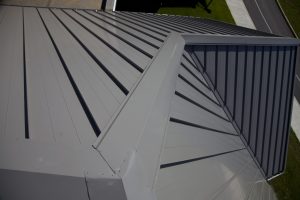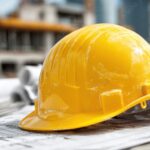
As weather events become more frequent and severe, the importance of resilient, high-performing roofing systems has never been more urgent, and metal has become a popular material to help fill this need. Metal roofing components are increasingly recognized for their aesthetic and structural benefits and their vital role in protecting buildings against wind, rain, hail, fire, and other environmental threats.
Building codes have evolved concurrently with these mounting challenges, setting new performance benchmarks that demand more from both manufacturers and contractors. From edge metal and gutters to emerging standards for walls and fascia, this article explores how key codes and standards have shaped metal roofing components and how forward-thinking contractors can stay ahead.
The evolution of building codes for metal roofing components
IBC & ES-1: Setting the foundation for perimeter securement (2003-present)
The adoption of ANSI/SPRI ES-1 into the International Building Code (IBC) in 2003 was a turning point for the roofing industry. It formalized the need for edge metal components–fascia and coping systems–to meet specific wind resistance performance criteria. The code requirement arose from a sobering reality: roof edge failure is a leading cause of system-wide roof failure during high-wind events.
ES-1 ensures edge metal is tested for its ability to withstand uplift forces at the roof perimeter, where pressures are typically most extreme. Yet while ES-1 compliance is now a baseline requirement, not all ES-1-rated products perform equally. Factors such as material gauge, fastener spacing, attachment methods, and system engagement can all influence performance.
As a result, ES-1 should not be viewed as a checkbox, but rather as a framework for evaluating complete edge metal assemblies that match a building’s design pressures and geographic risk factors. It also underscores the need for installation by trained, certified professionals who follow manufacturer specifications to preserve code compliance and warranty coverage.
GT-1: A new standard for gutter testing
Introduced as a companion to ES-1, the GT-1 standard focuses specifically on the wind performance of gutter systems–a previously overlooked weak point in many commercial roofing assemblies. GT-1 evaluates gutter assemblies for structural integrity and security under simulated wind load conditions.
As the industry embraces GT-1, contractors and specifiers should look for pre-tested gutter solutions that meet this benchmark.
ASCE-7 and tornado code adoption
The most recent edition of ASCE-7–the standard governing minimum design loads for buildings and structures–now includes provisions specific to tornado-prone regions. This update introduces higher wind load criteria for structures in areas identified as high risk, reflecting the growing frequency and destructiveness of tornado events.
While not all jurisdictions have adopted these tornado-specific criteria, the trend is clear: code bodies are moving toward more granular, hazard-specific performance expectations. Contractors must be prepared to adapt their specifications and product selections based on regional code requirements, especially regarding wind resistance at the roof perimeter.
Fire resistance: Metal vs. traditional materials
Beyond wind and water, fire risk is also reshaping the roofing industry. The increased risk of wildfires across the country has led code officials and insurance providers to favor fire-resistant roofing materials over traditional asphalt shingles. Metal, tile, and slate systems have emerged as preferred solutions with superior fire performance.
In Florida, for instance, homeowners and commercial developers are now seeing increased insurance premiums for buildings with asphalt and other flammable roofs. This economic pressure is accelerating the adoption of metal roofing as a practical, code-aligned solution.
Material innovations and industry trends
The shift to aluminum: Performance and cost considerations
As building codes evolve, thicker, more robust materials are incorporated into roofing systems. Aluminum, for example, is gaining popularity over steel in certain applications due to its lightweight nature and superior corrosion resistance–a key benefit in coastal and high-wind environments.
Manufacturers innovate with new profiles and edge designs that balance performance and cost. These advancements allow for the use of lighter-gauge aluminum without compromising strength.
VSH ratings and severe hail protection
With hailstorms becoming more damaging and costly, the industry is shifting toward Very Severe Hail (VSH) rated assemblies. These systems are tested to withstand the impact of large hailstones without additional protection layers such as cover boards, which are often required in membrane-based systems.
By contrast, metal panels inherently offer high impact resistance, making them a cost-effective solution for regions where hail is a primary concern. Contractors should consider these performance benefits when working in hail-vulnerable markets.
New testing standards on the horizon
Looking ahead, the Metal Construction Association (MCA) is developing new standards that will enhance performance validation for metal roof components. Known as FTS-1, the forthcoming testing standard is designed to evaluate the performance of residential edge metal components.
What do these changes mean for contractors
Building codes are no longer static references for contractors, but dynamic frameworks that reflect emerging risks and regional realities. Staying current requires proactive engagement with manufacturers, suppliers, and code bodies. The research and development efforts of companies are focused not just on meeting today’s codes but on anticipating the future. By investing in pre-tested, code-ready assemblies, contractors can reduce risk, ensure compliance, and streamline project execution.
With contractors facing increased pressure to verify wind-load ratings, fire resistance, and installation requirements in every project, working with a single-source manufacturer can reduce friction across every project phase.
Training and support: The final piece of the puzzle
Of course, code compliance depends not only on the product but also on the quality of installation. Contractors can access comprehensive training resources, technical guidance, and hands-on workshops to ensure roofing crews are well-equipped to deliver performance-tested systems to spec, benefitting from expert-backed support and ensuring proper installation and code compliance without added complexity.
Karan Patel is the Elevate Commercial Roofing Systems metal product manager. He began his career in the building design and construction industry and has specialized in roofing for the past 10 years. Patel’s experience includes leading R&D for numerous roofing products, measuring technologies, and leading sales training programs. He holds a bachelor’s degree in architectural and mechanical engineering, a master’s degree in quantitative management, and a master’s degree in business administration with a concentration in marketing.





